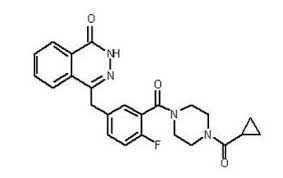FDA approves olaparib for adjuvant treatment of high-risk early breast cancer

On March 11, 2022, the Food and Drug Administration approved olaparib (Lynparza, AstraZeneca Pharmaceuticals, LP) for the adjuvant treatment of adult patients with deleterious or suspected deleterious germline BRCA-mutated (gBRCAm) human epidermal growth factor receptor 2 (HER2)-negative high-risk early breast cancer who have been treated with neoadjuvant or adjuvant chemotherapy. Patients must be selected for therapy based on an FDA-approved companion diagnostic for olaparib
Approval was based on OlympiA (NCT02032823), a randomized (1:1), double-blind, placebo-controlled, international study of 1836 patients with gBRCAm HER2-negative high-risk early breast cancer who completed definitive local treatment and neoadjuvant or adjuvant chemotherapy. Patients were randomized to receive either 1 year of olaparib tablets 300 mg orally twice daily or placebo. Patients were required to have completed at least 6 cycles of neoadjuvant or adjuvant chemotherapy containing anthracyclines, taxanes, or both. Patients with hormone receptor positive breast cancer were allowed to continue concurrent treatment with endocrine therapy per local guidelines.
The primary efficacy endpoint was invasive disease-free survival (IDFS), defined as the time from randomization to date of first recurrence defined as invasive loco-regional, distant recurrence, contralateral invasive breast cancer, new cancer, or death from any cause. For IDFS, there were 106 events (12%) in the olaparib arm and 178 events (20%) in the placebo arm (HR 0.58; 95% CI: 0.46, 0.74; p<0.0001). IDFS at 3 years was 86% (95% CI: 82.8, 88.4) for patients receiving olaparib and 77% (95% CI: 73.7, 80.1) for those receiving placebo. An additional efficacy endpoint was overall survival. There were 75 deaths (8%) in the olaparib arm and 109 deaths (12%) in the placebo arm (HR 0.68; 95% CI: 0.50, 0.91; p=0.0091). A statistically significant improvement in IDFS and OS was demonstrated in patients in the Lynparza arm compared with the placebo arm.
The most common adverse reactions (≥10%) in the OlympiA study were nausea, fatigue (including asthenia), anemia, vomiting, headache, diarrhea, leukopenia, neutropenia, decreased appetite, dysgeusia, dizziness and stomatitis.
The recommended olaparib dose is 300 mg taken orally twice daily, with or without food for up to one year.
03/14/2022



